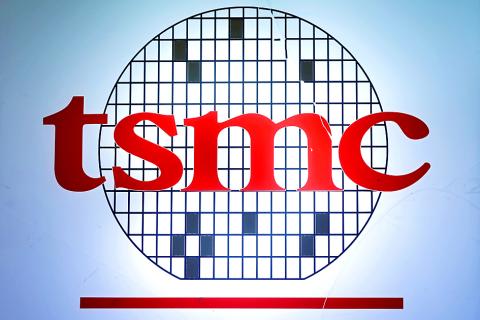Taiwan Semiconductor Manufacturing Co (TSMC, 台積電) yesterday said it would continue supplying wafers and technologies to Huawei Technologies Co (華為) as its exports are in full compliance with international trade rules, despite the US’ latest sanctions on the Chinese firm.
The chipmaker’s move came as a slew of global firms followed the lead of Aphabet Inc’s Google in cutting ties with the world’s No. 2 smartphone maker after Washington put Huawei on a blacklist.
TSMC, which counts Huawei among its top clients, said that it is the company’s long-term practice to conduct due diligence on every product it exports to make sure it is in compliance with international trade rules.

Photo: Reuters
“Based on our due diligence, we do not anticipate any major changes in how we ship wafers and how we deliver technologies to this client,” TSMC spokesperson Elizabeth Sun (孫又文) said on the sidelines of the chipmaker’s annual technology symposium in Hsinchu.
TSMC products contain less than 25 percent US-origin software and technology during the production process, Sun said, citing an internal assessment and an appraisal from an outside counsel from the US.
“We are our customers’ enabler. That includes HiSilicon Technologies Co (海思半導體),” Sun said.
HiSilicon helps design in-house premium mobile processors, including the Kirin family used in Huawei’s high-end smartphones.
TSMC said that some of it clients have said they would stop could lead to reduced orders from certain clients.
The company does not plan to revise down its second-quarter financial forecast.
It is sticking to its forecast of revenue growing at a quarterly pace of 7 percent this quarter.
TSMC said it does not plan to accelerate capacity expansion at its new factory in Nanjing to cope with the escalating US-China trade dispute.
Its goal is to boost annual capacity at the 12-inch fab to 15,000 wafers by the end of this year and to 20,000 wafers next year.
TSMC chief executive officer C.C.Wei (魏哲家) added that the company is committed to investing heavily in Taiwan.
Over the past five years, TSMC has spent US$50 billion on capacity expansion and technology development, he said.
This year, the company plans to invest between US$10 and US$11 billion on new facilities and equipment, which should increase total annual capacity by about 2 percent to 12 million wafers.
TSMC has started equipment installation at its Fab 18, paving the way for the company to produce the world’s first 5-nanometer chip in the first quarter next year.
The company has also earmarked a piece of land for next-generation 3-nanometer chips, Wei said.

CHIP RACE: Three years of overbroad export controls drove foreign competitors to pursue their own AI chips, and ‘cost US taxpayers billions of dollars,’ Nvidia said China has figured out the US strategy for allowing it to buy Nvidia Corp’s H200s and is rejecting the artificial intelligence (AI) chip in favor of domestically developed semiconductors, White House AI adviser David Sacks said, citing news reports. US President Donald Trump on Monday said that he would allow shipments of Nvidia’s H200 chips to China, part of an administration effort backed by Sacks to challenge Chinese tech champions such as Huawei Technologies Co (華為) by bringing US competition to their home market. On Friday, Sacks signaled that he was uncertain about whether that approach would work. “They’re rejecting our chips,” Sacks

Taiwan’s long-term economic competitiveness will hinge not only on national champions like Taiwan Semiconductor Manufacturing Co. (TSMC, 台積電) but also on the widespread adoption of artificial intelligence (AI) and other emerging technologies, a US-based scholar has said. At a lecture in Taipei on Tuesday, Jeffrey Ding, assistant professor of political science at the George Washington University and author of "Technology and the Rise of Great Powers," argued that historical experience shows that general-purpose technologies (GPTs) — such as electricity, computers and now AI — shape long-term economic advantages through their diffusion across the broader economy. "What really matters is not who pioneers

BUBBLE? Only a handful of companies are seeing rapid revenue growth and higher valuations, and it is not enough to call the AI trend a transformation, an analyst said Artificial intelligence (AI) is entering a more challenging phase next year as companies move beyond experimentation and begin demanding clear financial returns from a technology that has delivered big gains to only a small group of early adopters, PricewaterhouseCoopers (PwC) Taiwan said yesterday. Most organizations have been able to justify AI investments through cost recovery or modest efficiency gains, but few have achieved meaningful revenue growth or long-term competitive advantage, the consultancy said in its 2026 AI Business Predictions report. This growing performance gap is forcing executives to reconsider how AI is deployed across their organizations, it said. “Many companies

TAIWAN VALUE CHAIN: Foxtron is to fully own Luxgen following the transaction and it plans to launch a new electric model, the Foxtron Bria, in Taiwan next year Yulon Motor Co (裕隆汽車) yesterday said that its board of directors approved the disposal of its electric vehicle (EV) unit, Luxgen Motor Co (納智捷汽車), to Foxtron Vehicle Technologies Co (鴻華先進) for NT$787.6 million (US$24.98 million). Foxtron, a half-half joint venture between Yulon affiliate Hua-Chuang Automobile Information Technical Center Co (華創車電) and Hon Hai Precision Industry Co (鴻海精密), expects to wrap up the deal in the first quarter of next year. Foxtron would fully own Luxgen following the transaction, including five car distributing companies, outlets and all employees. The deal is subject to the approval of the Fair Trade Commission, Foxtron said. “Foxtron will be